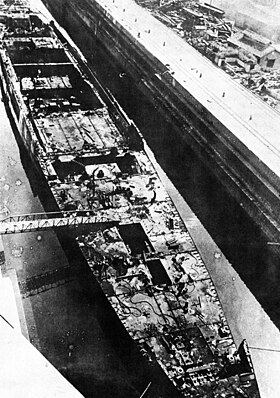Ibuki (ship, 1943)
|
|
|
|---|---|
 Ibuki in dry dock - 64% scrapped |
|
| Overview | |
| Type | Heavy cruiser, later converted to a light aircraft carrier |
| Shipyard | |
| Keel laying | Early 1942 |
| Launch | May 21, 1943 |
| Whereabouts | Handed over to the Americans unfinished in 1945, scrapped in 1947 |
| Technical specifications | |
| displacement |
12,200 ts |
| crew |
1,595 men |
| speed |
As a cruiser: 33 knots (61 km / h) |
| Armament |
4 × 76-mm guns |
| Planes |
27 |
The Ibuki ( Japanese 伊 吹 ) was the last heavy cruiser to be named and the construction of which began by the Imperial Japanese Navy . Eventually it was 80% completed as a light aircraft carrier .
Start of construction as a heavy cruiser
It was commissioned as a slightly modified version of the Tone class as part of the 1941 building program . She was to receive eight 8-inch guns on the forecastle and a flight deck with a catapult for several reconnaissance planes aft. However, before the keel was laid in 1942, her plans were changed to those of a modified Mogami-class cruiser .
The Ibuki should have the same armament as the Mogami . This consisted of ten 20.3 cm guns in five twin towers. Three of the towers were to be installed on the forecastle and two aft. The secondary armament was to consist of eight 127 mm anti-aircraft guns , sixteen 60.9 cm torpedo tubes and two catapults for three seaplanes. The maximum speed should be 33 knots . In order to comply with the Washington Fleet Agreement , the ships of the Mogami class were built in such a way that as much weight as possible was saved, although they had to be extensively rebuilt a short time later in order to eliminate various defects. Since the Ibuki was commissioned after Japan withdrew from the Washington Naval Agreement, it was no longer bound to the displacement limit of 10,000 t for cruisers and was planned from the outset with a displacement of 12,200 t, which was a better balance between armament, armor and speed and should ensure seaworthiness.
Following the Japanese defeat in the Battle of Midway , the construction of the Ibuki was slowed as the construction of new aircraft carriers now had priority to make up for the losses suffered. On June 1, 1942, another Ibuki-class cruiser with hull number 301 was laid down, but its construction was canceled a month before it was given a name. In 1943 No. 301 was scrapped while the Ibuki was launched on May 21, 1943 . A month later, however, before the main armament was installed, further expansion was stopped.
Conversion to an aircraft carrier
After the construction freeze, the Imperial Navy examined the possibility of converting the Ibuki into a protected supplier in order to supplement the sea supply for the fleet, which was suffering from severe failures. However, the new construction and conversion of aircraft carriers was given a higher priority and the Ibuki was intended for conversion into a light aircraft carrier due to its already completed shell. Because of this, she was towed to Sasebo in November 1943 .
The Ibuki was provided with a continuous flight deck and a navigating bridge on the starboard side . She was with four 76-mm cannons and 48 25-mm type 96 - MK very lightly armed and could accommodate only 27 planes - less than other Japanese escort carriers. In addition, it was provided with lanes for up to 30 depth charges. Her maximum speed was reduced to 29 knots, which was still considered sufficient for fleet operations. Later on, a ship's radar and launchers for new types of 120 mm anti-aircraft missiles were installed.
By the end of 1944, the shortage of suitable aircraft, experienced pilots, and aviation fuel had become so severe that the small number of aircraft carriers remaining was no longer considered relevant to the course of the war. Nevertheless, the renovation continued until March 1945, when the damage caused by the American bomber offensive and the lack of material due to the American naval blockade made it impossible to continue. After the capitulation of Japan , the approximately 80% completed Ibuki was handed over to the American occupation forces, which had it scrapped in Sasebo in 1947.
literature
- 空 母 〈2〉 写真 日本 の 軍艦 〈第 4 巻〉 ( e.g. Volume 2: Photos of Japanese Warships, 4th edition ), Mitsuhito, October 1989, ISBN 4-7698-0454-7 (Japanese).